Automatic Insulating Glass Production Line
Related Products
Automatic Insulating Glass Production Line LB2500W
Features:
1.PLC control system with touch screen operation.
2.Designed for curtain wall glass, double layer insulating glass and three layer insulating glass.
3.Gear and rack synchronous device designed for insulating glass press.
4.Rinsing sector and water flow system adopt rustproof and rot-proof material which can bear roughly usage.
5.Full distance automatic changeable frequency speed adjustment, automatically put together the double glass outside the press parts which can save work waiting time and improve production efficiency.
6.The glasses can be rinsed continuously, the machine can distinguish the first and the second glass automatically, waiting time is zero.
Parameters:
Input voltage | 380V/50HZ |
Min. glass size | 450*450mm |
Max. glass size | 1800*2500mm |
Pane Glass thickness | 3~12mm |
Max I.G. Unit thickness | 12~40mm |
Glass cleaning speed | 0~8m/min |
Working speed | 2~22m/min |
Input power | 29.5KW |
Overall dimension | 15000*1800*2630mm |
Frequently Asked Questions
Automatic Insulating Glass Production Line is a fully automated system designed to manufacture insulating glass units (IGUs) used in windows, doors, and facades. The line typically includes processes like cutting, cleaning, edge sealing, and assembling glass layers to create energy-efficient insulated glass products.
Increased Efficiency: Automation significantly reduces human intervention, speeding up the production process and improving throughput.
High Precision: Automated systems ensure precise measurements, consistent product quality, and minimal errors.
Energy Efficiency: Insulated glass products help reduce energy consumption by improving heat retention and insulation properties.
Cost Reduction: With automated operations, labor costs decrease, and the production process becomes more cost-effective in the long run.
The line can work with different types of glass, including clear, tinted, low-emissivity (Low-E), tempered, and laminated glass, depending on the customer’s requirements.
 +8615753113189
+8615753113189









